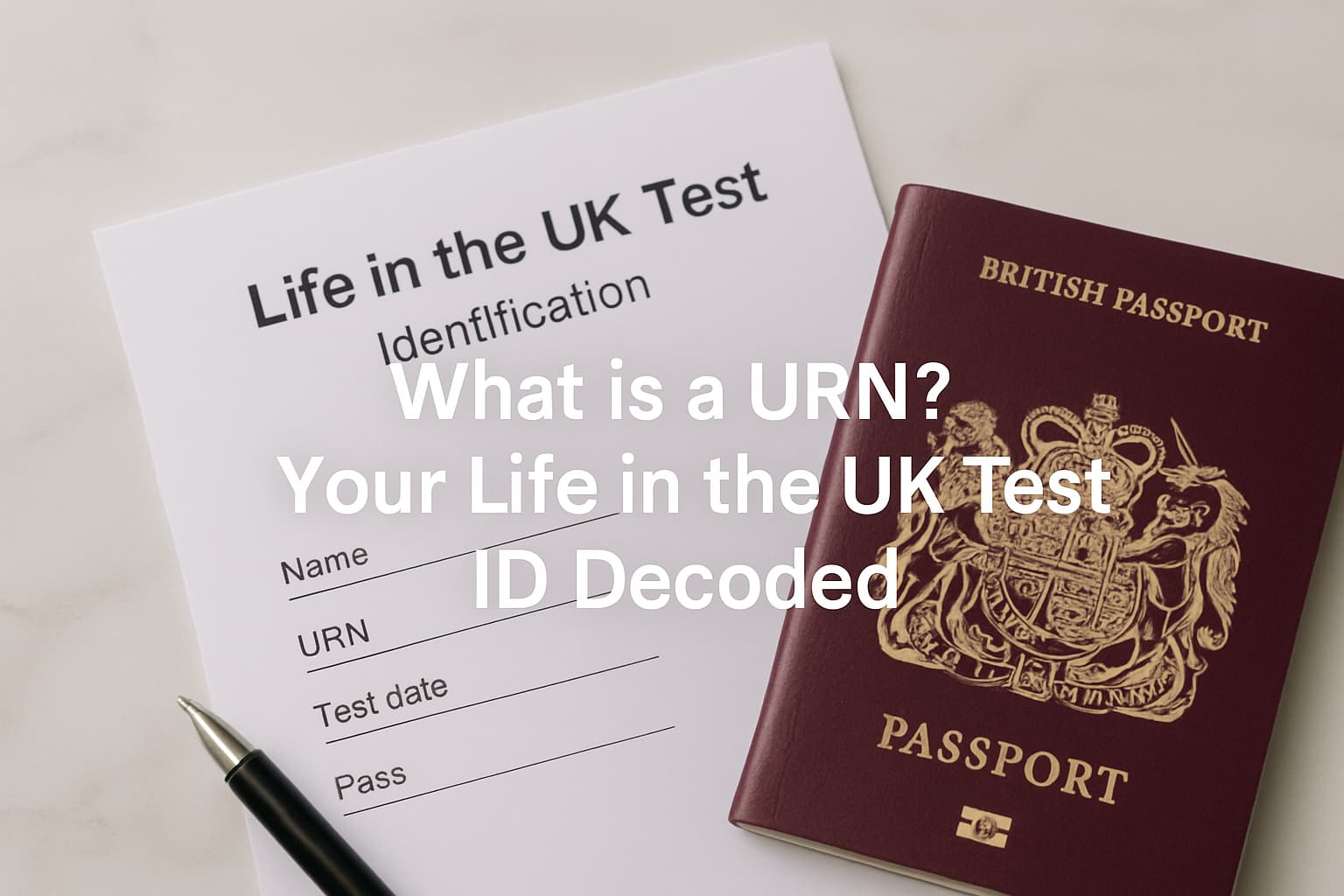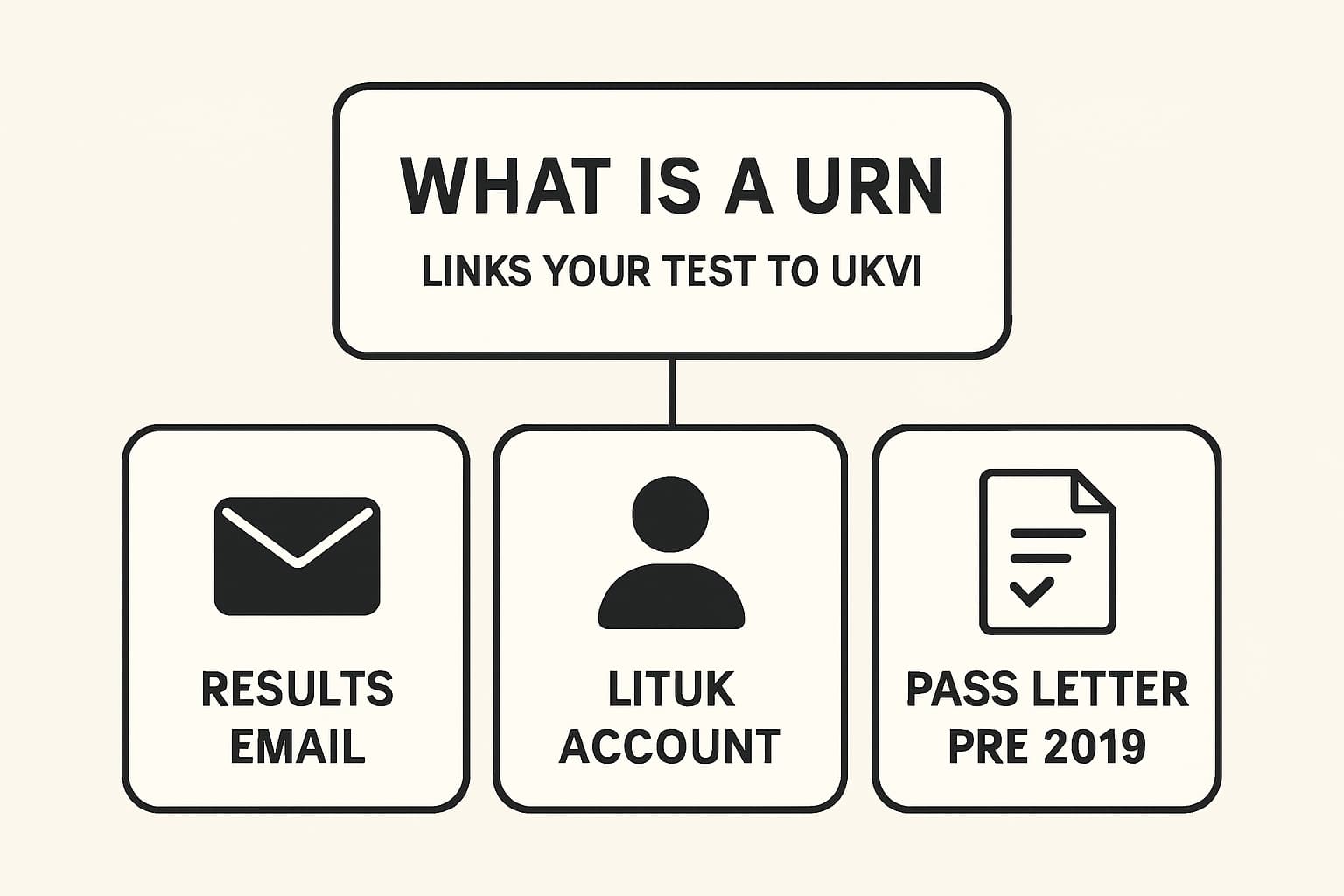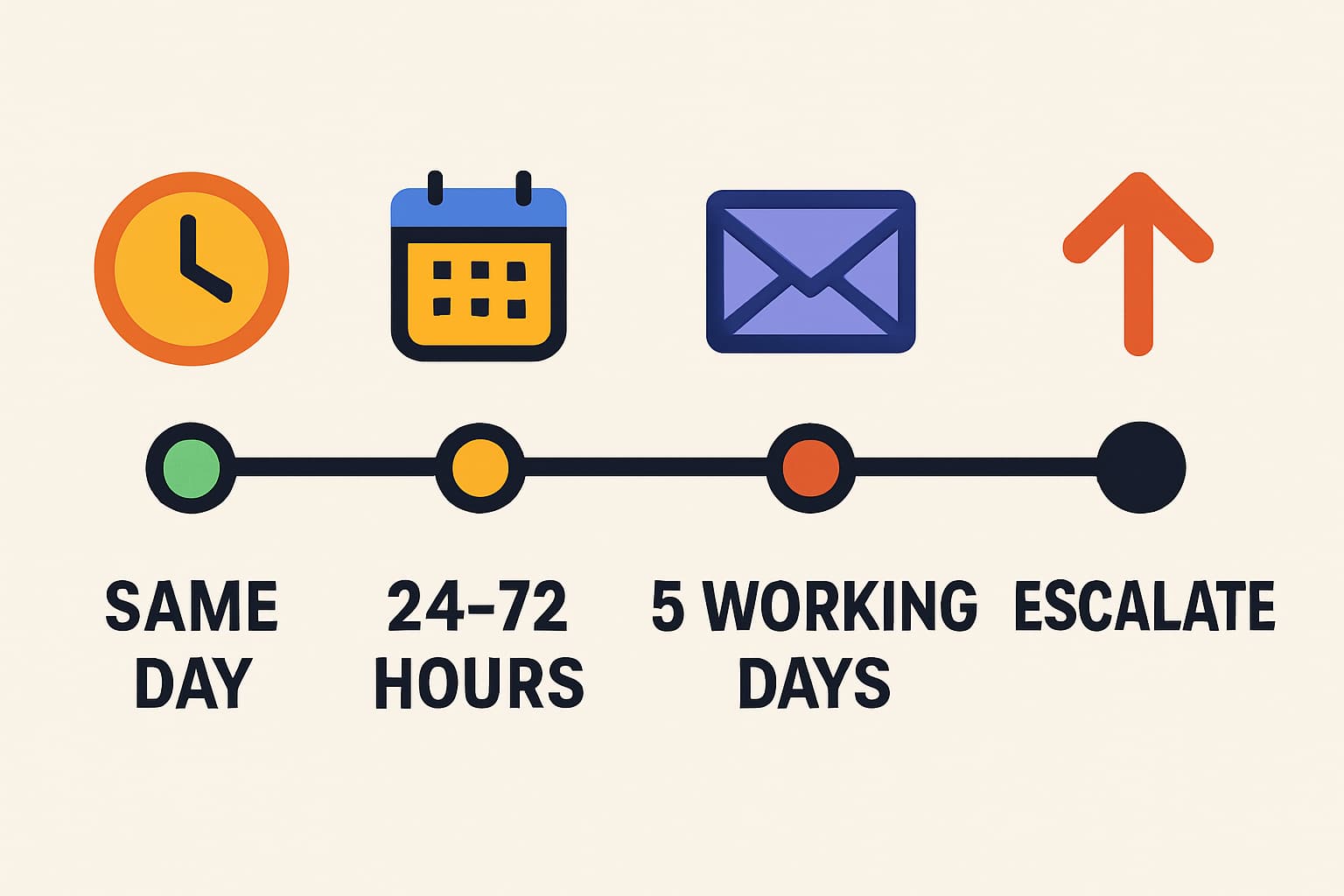What is a URN? Your Life in the UK Test ID Decoded

You’ve passed or are about to pass the Life in the UK Test and keep seeing “URN.” What is it, where do you find it, and why does it matter? This guide decodes your Unique Reference Number so your UKVI application moves forward without delays.
Inside: a quick definition, where to locate your URN, how Home Office systems verify it, common errors to avoid, timelines, troubleshooting, and a practical post‑test checklist. We’ll also show how the Life in the UK Test App helps you stay organised and avoid retakes.
Quick answer: What is a URN in the Life in the UK Test?
URN (Unique Reference Number): the official ID that links your Life in the UK Test result to Home Office systems for ILR or citizenship applications.
After you finish the test, you receive a URN by email and in your Life in the UK (LitUK/PSI) account. UK Visas and Immigration (UKVI) caseworkers use this number to validate your pass electronically when you apply for settlement (ILR) or citizenship. According to official guidance, you must score at least 75% and you’ll get a unique reference number that you need for your application.

Where to find your URN after passing
Your URN appears in multiple places. Start here:
- Results email sent shortly after you sit the test (typically within minutes).
- Your LitUK/PSI account under results history.
- Older pass letter if you tested before 17 December 2019.
On your pass notification or confirmation email
Under the current system, PSI sends an email when you sit the test with your URN, whether you passed or failed. If you pass, this URN is the one you’ll use on UKVI forms. The official LitUK FAQ notes you’ll usually receive the email with your URN within about 10 minutes.
Tip: Search your inbox for phrases like “Life in the UK,” “PSI,” “URN,” or your test date. Check spam and promotions folders.
In your test booking account
From 17 December 2019, PSI stopped issuing printed pass letters; results live in your online account. Log in to your LitUK/PSI account and go to your results history or candidate profile to see the URN displayed against the test result. This is confirmed in Home Office caseworker guidance: the URN shown in the applicant’s account is the reference you must include on the form.
Booking reference vs URN: Your booking confirmation number is not the same as your URN. Only the URN verifies your test result to UKVI.
If you retook the test: which URN is the one to use?
Each attempt generates its own reference. Use the URN tied to the successful attempt only. If you sat multiple tests, cross‑check the pass date next to the URN in your account or email to avoid mixing attempts.
How the Home Office uses your URN to verify your result
UKVI caseworkers validate your pass directly in Home Office systems using your URN. They can view your result—and even your test photo—through the verification portal referenced in the caseworker guidance. This reduces the need for physical documents and speeds up decision making.
Behind the scenes: the electronic verification flow
Here’s a simplified flow of how verification works:
- You sit the test with PSI and show ID at the centre.
- PSI records your result, links it to your identity, and issues your URN.
- Data sync: Results feed into systems that UKVI caseworkers can access.
- UKVI lookup: When you submit Form AN (citizenship) or a SET form (ILR), the caseworker checks your URN.
- Match found: If name, date of birth, and other identifiers align, the record is verified electronically.
Home Office guidance indicates caseworkers can use an online verification portal to view your test result and photograph, enabling end‑to‑end digital checks.
Identity matching: why your name and DOB must match
Verification depends on the URN and a match to your personal details. Mismatches—such as a misspelled name, switched order of family/given names, or a different date of birth—can block verification and delay your application.
Best practices to prevent mismatches:
- Enter your full legal name exactly as it appears on your passport/BRP when booking the test.
- Keep the same date of birth format across all records.
- If your ID changed after the test (new passport), include both document numbers in your application and update the provider if requested.
URN vs pass certificate: what is the difference?
The URN is a digital identifier; the pass letter is a document. Since December 2019, PSI typically does not issue printed pass letters—your URN in the LitUK account is what UKVI uses.
| Item | What it is | Who needs it | When used |
|---|---|---|---|
| URN (Unique Reference Number) | Digital reference linking your Life in the UK Test result to UKVI | You and UKVI caseworkers | Entered on ILR/citizenship forms; used for electronic verification |
| Pass letter/notification | Old system paper letter (pre‑Dec 2019) or confirmation email | You, occasionally requested by advisers | Proof of pass if asked; not always required for UKVI because of digital checks |
Official guidance confirms that from 17 December 2019, results are accessed via your LitUK account and the URN shown against your result is what you include on forms. If you tested before 17 December 2019, you’ll have a 7‑digit test reference ID on the pass letter instead of a URN.
When and where you will be asked for your URN
Expect to provide your URN whenever UKVI needs to verify your Life in the UK Test pass:
- Naturalisation (Form AN) applications.
- Settlement (Form SET) variants (e.g., SET(M), SET(O), SET(LR)).
- BRP replacement or renewal when evidence checks are needed.
- Travel document or other immigration enquiries where UKVI needs to confirm KOL (Knowledge of Life in the UK).
- Solicitor/adviser requests to complete your forms accurately.
Citizenship (Form AN) and Settlement (Form SET)
The Form AN guidance makes clear that if you passed on or after 1 October 2019, you must enter your test reference number (URN). Type it exactly as shown (including slashes or hyphens if present) to avoid verification errors.
BRP renewal, travel documents, and UKVI enquiries
When contacting UKVI, quoting your URN helps staff locate your record quickly. Always have your URN and personal details ready, along with any UKVI application reference.
Using a representative: sharing your URN with a solicitor
Only share your URN with a trusted representative. Use secure channels (encrypted email or secure client portals). Never post your URN on social media or public forums.
URN format, validity, and retention
Knowing how a URN looks and behaves helps you enter it correctly and keep it safe.
Typical formats and case sensitivity tips
For tests on or after 17 December 2019, the reference often follows a format like “HOM/010114/123456/123456789” in the guidance for Form AN. Copy the URN exactly as displayed—include all characters and separators.
- Copy‑paste carefully: Avoid extra spaces before/after.
- Zero vs letter O: Double‑check similar characters.
- Upper/lower case: Use the case shown to minimise typos.
If you tested before 17 December 2019, your result letter shows a 7‑digit test reference ID at the top.
Duplicates and multiple attempts
Each attempt has a unique reference. Only the pass attempt URN matters for your application. If you sat more than once, match the URN to the pass date in your email or account.
How long to keep it and where to store it safely
There’s no expiry date on passing the Life in the UK Test, so keep your URN indefinitely as part of your records. Store it in secure password‑protected notes or a reputable password manager. Avoid screenshots saved to shared photo folders.
Troubleshooting: common URN issues and fixes
Use this step‑by‑step playbook to resolve frequent URN problems fast.
Cannot find your URN
- Search email for “Life in the UK,” “PSI,” “URN,” and your test date; check spam.
- Log in to your LitUK/PSI account and check results history.
- Request a resend via the LitUK portal or support.
- Contact the test provider with your name, DOB, and ID used on test day to locate your record.
URN not recognised by UKVI systems
Common causes and fixes:
- Data sync delay: Many records verify same day, but some take 24–72 hours to propagate. Try again later.
- Typo or format issue: Re‑enter the URN exactly as displayed, including separators.
- Identity mismatch: Ensure your name and DOB on the application match the test record.
- Outdated document number: If your passport changed post‑test, add both old and new numbers and notify the provider if advised.
Name or ID mismatch with your test record
If your application details differ from the test record, ask the provider about correcting personal details. Provide evidence (passport, BRP, deed poll, marriage certificate). Once corrected, UKVI can usually complete verification.
Lost access to the email or test account
Use the provider’s account recovery. Be ready for identity checks (security questions, ID scans). If needed, request re‑issue of your result confirmation to a new email after verification.
Test centre errors and how to get them fixed
If the centre entered details incorrectly (spelling, DOB), raise a support ticket promptly. Provide clear scans of your passport/BRP and any name change evidence so the provider can correct the record linked to your URN.
Scam alerts: protect your URN and personal data
- Only share your URN with UKVI or a trusted legal representative.
- Beware of emails asking for payment to “activate” a URN—this is not required.
- Verify sender domains (e.g., official PSI or gov.uk addresses) before clicking links.
Timing: when your URN becomes active
Most URNs become usable quickly, but some take longer to sync across systems.
Same‑day vs 24–72 hour sync
The provider states most candidates receive their URN email within minutes, and many records verify on the same day. However, allow up to 24–72 hours for data propagation before assuming there’s a problem.
Weekends, bank holidays, and known delays
Non‑working days can slow back‑office updates. If you finished your test late on a Friday, checks may complete the next working day. Build a timeline buffer into your application.
What to do if verification still fails after a week
- Confirm your URN in your account and re‑enter it carefully.
- Check personal details on your application match the test record.
- Contact the test provider to confirm the record and request any corrections.
- Contact UKVI quoting your application reference and URN to escalate.

After you pass: next steps using your URN
Turn your URN into action. Here’s how to keep momentum toward ILR or citizenship.
Quick checklist for ILR or citizenship
- Locate your URN in your email or LitUK account.
- Check personal details match your passport/BRP.
- Gather documents (see bundle below).
- Complete the form (AN or relevant SET) and enter the URN exactly.
- Pay the fee and submit; book biometrics if prompted.
- Track updates using your application reference.
Document bundle: what to prepare alongside your URN
- Current passport and BRP (or other valid ID).
- Proof of residence where required.
- English language evidence (if applicable).
- Any name change documents.
- Application reference numbers from UKVI correspondence.
When to contact UKVI or the test provider
- Provider (PSI/LitUK): Missing URN email, account issues, or corrections to your test record.
- UKVI: Application form queries, verification delays beyond a week, or case‑specific guidance.
How the Life in the UK Test App supports you post‑test
The Life in the UK Test App helps you avoid retakes, stay organised, and store your URN securely—so you move from pass to application with confidence.
- Secure notes to save your URN and pass date in one place, protected on your device.
- In‑app checklists to track tasks for ILR or citizenship.
- Readiness score and Brit‑Bear learning assistant to keep knowledge fresh in case UKVI asks follow‑up questions.
- Over 650 practice questions with explanations and Hard Mode mock tests to maintain mastery.
- Offline handbook access so you can review key facts anytime.
Get the app to stay organised and avoid costly retakes: Download on the App Store or Get it on Google Play.
Secure notes: save your URN and pass date in one place
Record your URN, pass date, and the exact name format used on test day. Set a reminder to copy the URN into your application form to avoid typos.
In‑app checklists and readiness insights for next steps
Use the checklists to structure your application timeline (documents, fees, biometrics). The readiness score highlights weak topics so you can refresh quickly.
Avoid retakes: revise weak topics with Brit‑Bear
If a caseworker requests clarification, quickly revise weak areas identified by the app’s smart assistant. Staying sharp helps you avoid unnecessary retests.
Offline handbook and mock tests for confidence
Traveling or low on data? Keep reviewing the official handbook content offline and run a Hard Mode mock to simulate test pressure anytime.
FAQs about URNs
Is a URN the same as candidate ID or booking reference?
No. The URN is the unique identifier that links your test result to UKVI. Booking references and candidate IDs are administrative and will not verify your pass.
Does my URN expire?
No. There is no expiry on passing the Life in the UK Test. Keep your URN safely for future applications or queries.
Can I apply without my pass letter if I have the URN?
Yes, in most cases UKVI verifies electronically using the URN. Always follow the latest UKVI form guidance for what to upload.
What if I changed my passport after the test?
Provide both the old and new passport numbers if requested and ensure your personal details match across records. Ask the provider about updating your test record.
Official guidance and good‑to‑know resources
Get the Life in the UK Test App
Prepare smarter, store your URN securely, and glide from pass to application without stress.